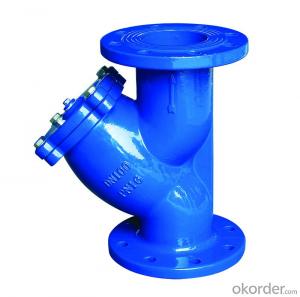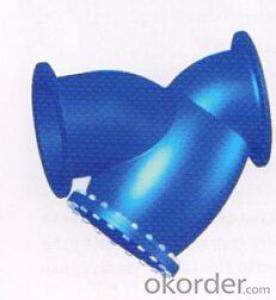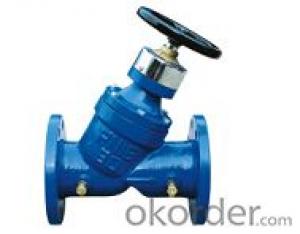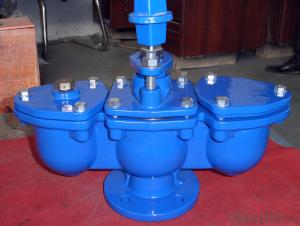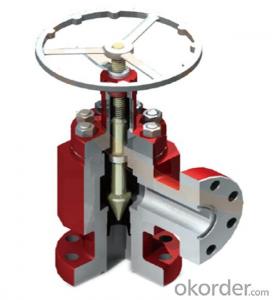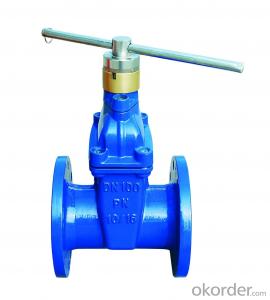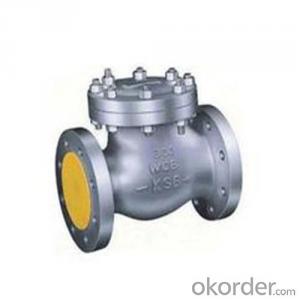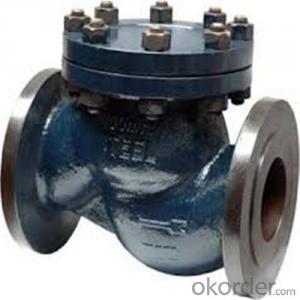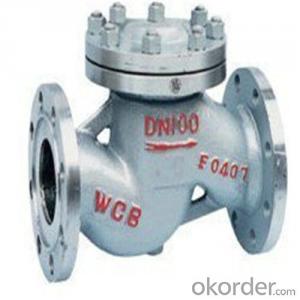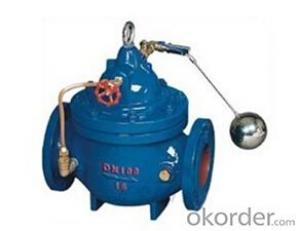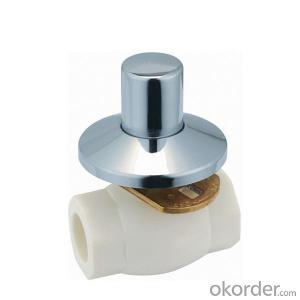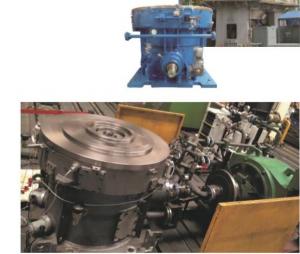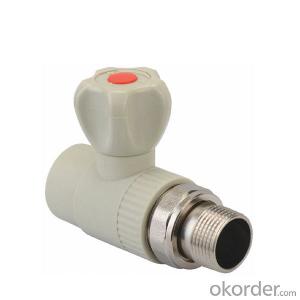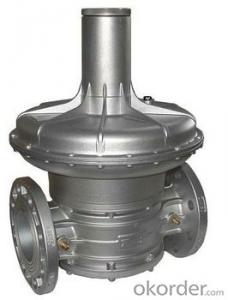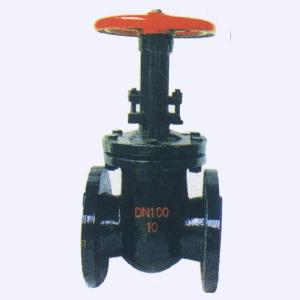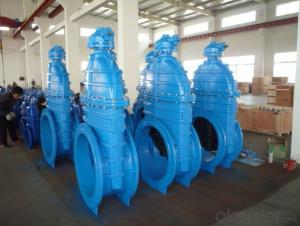DN200 DUCTILE IRON STRAINER BRITAIN STANDARD
- Loading Port:
- Tianjin
- Payment Terms:
- TT OR LC
- Min Order Qty:
- 1 set
- Supply Capability:
- 5000 set/month
OKorder Service Pledge
OKorder Financial Service
You Might Also Like


General valve using the market long-term, widespread Water Leakage, rust phenomenon, soft sealing gate valve produced by the introduction of foreign advanced technology of the enterprise. To overcome the poor sealing gate valve, general elastic fatigue, rust and other defects. Soft sealing gate valve is a traditional valve replacement products, the compensation effect of using flexible gate produce small deformation, achieve good sealing effect, the valve has a light switch, reliable sealing, good elastic memory and long service life and other significant advantages, can be widely used in water, sewage, construction, food, medicine, metallurgy, electric power, textile, energy systems, fluid pipeline regulation and closure devices as.
The characteristics of:
- flat style seat
The traditional control valve often pass after washing due to foreign objects such as stone, wood, cement, paper, and other debris deposited on the valve at the end of the groove. Close but not close easily lead to the formation of Water Leakage phenomenon, the lower part of the soft sealing gate valve with water using the same flat design, easy to siltation caused by debris, the fluid unimpeded.
And the overall package glue
The valve plate is made of high-quality rubber overall, the outsourcing of plastic, making the domestic first-class rubber vulcanization vulcanization after the valve plate to ensure accurate geometry, and the rubber and ductile iron gate is connected firmly, not easy to fall off and good elastic memory.
And corrosion resistance
The valve body adopts epoxy coating powder, can prevent the corrosion and rust, and can be used for sewage systems.
And not easy to break
Traditional cast iron garden gate often hit foreign objects, collision or overlap caused by the fracture phenomenon. Because the valve to switch to ductile iron, this is the case already significantly reduced.
Three "O" ring seal
As the valve stem with three "0" ring ring seal design, can reduce friction when the switch is greatly reduced, Water Leakage phenomenon and can cut off the water supply construction not replace sealing ring.
And help to drink
Due to the internal body to non-toxic epoxy resin coating, gate of the inner and outer surfaces are completely coated with rubber and can not rust or corrosion of water available to drink.
- Casting valve
Valve body casting, precise geometry makes the body without any internal finishing to ensure that the valve seal.
And light weight
The valve is made of ductile cast, lighter in weight than conventional gate weight about 20%-30%. Convenient installation and repair.
Overview:
General valve using the market long-term, widespread Water Leakage, rust phenomenon, soft sealing gate valve produced by the introduction of foreign advanced technology of the enterprise. To overcome the poor sealing gate valve, general elastic fatigue, rust and other defects. Soft sealing gate valve is a traditional valve replacement products, the compensation effect of using flexible gate produce small deformation, achieve good sealing effect, the valve has a light switch, reliable sealing, good elastic memory and long service life and other significant advantages, can be widely used in water, sewage, construction, food, medicine, metallurgy, electric power, textile, energy systems, fluid pipeline regulation and closure devices as.
The characteristics of:
- flat style seat
The traditional control valve often pass after washing due to foreign objects such as stone, wood, cement, paper, and other debris deposited on the valve at the end of the groove. Close but not close easily lead to the formation of Water Leakage phenomenon, the lower part of the soft sealing gate valve with water using the same flat design, easy to siltation caused by debris, the fluid unimpeded.
And the overall package glue
The valve plate is made of high-quality rubber overall, the outsourcing of plastic, making the domestic first-class rubber vulcanization vulcanization after the valve plate to ensure accurate geometry, and the rubber and ductile iron gate is connected firmly, not easy to fall off and good elastic memory.
And corrosion resistance
The valve body adopts epoxy coating powder, can prevent the corrosion and rust, and can be used for sewage systems.
And not easy to break
Traditional cast iron garden gate often hit foreign objects, collision or overlap caused by the fracture phenomenon. Because the valve to switch to ductile iron, this is the case already significantly reduced.
Three "O" ring seal
As the valve stem with three "0" ring ring seal design, can reduce friction when the switch is greatly reduced, Water Leakage phenomenon and can cut off the water supply construction not replace sealing ring.
And help to drink
Due to the internal body to non-toxic epoxy resin coating, gate of the inner and outer surfaces are completely coated with rubber and can not rust or corrosion of water available to drink.
- Casting valve
Valve body casting, precise geometry makes the body without any internal finishing to ensure that the valve seal.
And light weight
The valve is made of ductile cast, lighter in weight than conventional gate weight about 20%-30%. Convenient installation and repair.


- Q:i need to know the setting of the valve and a little advice on the up and down of the valves
- As Bob said, you had probably best bite the financial bullet and get someone experienced to do it. With the bucket over shim designs, the shim you need to change is underneath the bucket, the device that rides against the camshaft. To change the shims, you have to remove the camshafts and when you replace them, you must get them timed exactly right or else you can have pistons hitting valves..not good at all. They put the shim under the bucket to keep the cam from spitting the shims out through the valve cover at high rpms. The older 2 valve 900-1000-1100-1300 Kaws have shim over bucket and can be changed with a special $20 tool, a little screwdriver and small magnet . However, you might consider getting a shop manual and checking the valve clearance yourself. If all are within specs, then there is no need to take it to a shop. My old KZ1000 went something like 110,000 miles and only need two shims changed in all that time, so your bike could very well be ok.
- Q:I somehow lost the valve cap to one of my tires. Do stores sell replacement caps? If so, would a place like Sears or VIP be a good place to look? If not, would a bike tire valve cap work?In the mean time, i took a cap off the fullest tire to put on this one(the lowest) was that good or bad idea?
- Tire Caps For Cars
- Q:When using seafoam through the PCV valve. Which side contains the vacuum? From the crank case of intake manifold? The brake booster line is very difficult to access and on their site it says I can apply seafoam through the pcv valve.
- Remove the PCV valve from the rocker arm cover remove the hose off the PCV valve shake the valve, is it springy? if yes it is OK put it back on. If not spray the top and bottom holes and shake it back and forth till you can feel it becoming springy Best world I can think of sort of feels like a ball bouncing inside when it's free afterwords spray it till it's clean then dry it and install it bak into position. The hose is the vacuum side but you DO NOT want to get the sea foam into the booster diaphragm or it will damage it, it's made of rubber and ea form will harm it as will any oil or lubricants that gets on it. The PCV valve is a controlled vacuum leak and it pulls engine gas out and recreates it to burn again and it supplies boost to the brake system as well. Hope this helps.
- Q:Holding my right hand up, I am a newbie :) any help is greatly appreciated.a) Comparing the shape of the valve to a golf tee, what is the correct name for the thinnest section of the valve(the part of the golf tee that goes into the ground)b) What is the correct name for the widest section of the valve(the part of the golf tee that the ball is placed on.c) The cylinder that the valve moves up and down in, is it just called the valve cylinder?d) In the valve cylinder?, how does the widest part of the valve keeps things sealed. Does it use a ring(simmilar to pistons) or is it some type of gasket material or is it just zero clearance metal to metal.e) The section of the (valve cylinder?) that is above the seal point or basicaly where the valve spring and the thinnest part of the valve is, does oil flow through here?f) Do (valve cylinders?) generate enough heat to warrant the need for coolant?Newbie City, I know. Any help is GREATLY appreciated.TY
- stem, surface, valve guide, o rings in some. some valve guides are plastic with no clearance. yes oil flow, yes water flows through the heads to cool vales and head.
- Q:First off I'm a girl. :) My 2.0 non turbo engine has a bent valve. I have been asked to pick up the valve. But I need to know if its for the intake or the exhaust. I know the guy how is going to fix it said he will have to sand down the cylender that it goes in it. The car sounds like it knocking when driving or sitting still. The guy who is going to fix it is at work right now and I'm suppose to order this part right now. Is it an intake or an exhaust valve?
- tell him that you dont sand down the seat.if he does,then he could get it so it wont seat right.he needs to lap the seat.now 1 of the valves are smaller then the other.if it backfires through the exhaust then its the exhaust valve.if he know how to do it,then all he has to do is take a piece of paper and hold it up to the tailpipe and see if it sucks the paper in.
- Q:1998 Ford Crown Victoria LX 4.6L Use 89 Octane BP, Shell, Chevron gas. When the engine is under stress(acceleration or going up incline) the engine sounds like the valves are chattering. I can increase the rpm's and the chattering goes away. Had the same problem with 95 Thunderbird 4.6 and have heard other ford cars going down the road with this problem. Air leak? Don't really want to use higher octane due to gas prices and possible engine damage. Also, in the thunderbird, i used a bottle of octane boost and the next day a valve spring broke. Was the octane boost a possible cause?
- it is not valve chatter, it is called Pinging, it is a fairly common problem, what it is caused by is hot spots in the engine, or by overly advanced spark timing, i would check your base timing, perhaps even back it off a degree or two, i would also run a bottle of marvel mystery oil, or gm top engine cleaner through a vacuum line to burn out the crud that has built up, the sum total of these repairs: about 15 bucks, the savings: your engine! as for your t-bird, it was the pinging that broke the valve spring, not the tank of hi octane. hope this helps
- Q:My washing machine had hot and cold water, but was leaking. I changed the inlet valve which stopped the leak, but now I have no hot water. When I put the setting on warm, the cold water runs for a bit. Then stops and no hot water comes. Any help?
- I suspect the leaking valve that was replaced was your washer's solenoid valve. Did you remember to turn the hot water supply valve on after you finished? That is the valve, next to the cold water supply valve, on/at the wall behind the washer. There are rubber hoses coming from those valves to the solenoid valves on your washer. If you forgot to turn it back on after replacing the leaking valve you'll get no water. If you turn off both the hot and cold supply valves on the wall you should be able to remove the rubber hoses right where they connect to the machine and check the water flow by directing them into a bucket or pan while you open the supply vales. If you have good pressure and flow make sure there is no debris clogging the screen, just inside there the hose connects to your machine. These can get blocked where the water won't pass or runs very slow. Sometimes it pays to check the simplest causes first. Good Luck. SS.
- Q:What is motor operated valve (MOV) please answer me if anybody have experiance in instrumentation filed, please explain overhauling and troble shooting
- Mov Valve
- Q:I have a 3-circuit sprinkler system in my yard (built by me, last year). I discovered this week that I overtightened the connection between the valves and the downstream pipes, and 2 of the three valves are cracked, and leaking, at the connection. I replaced all 3 valves, and now I need to reconnect them to the supply. But this means I'm working backward - when I bult the system last year, I worked downstream - I built the manifold first, connected the valves, then the remainder of each branch. Now, I have to make the new manifold fit the valves, and naturally, they don't line up perfectly. Any tips/tricks on connecting valves in this situation? Is there such a thing as flexible pipe that can withstand continuous pressure? I'm using unions at both ends of each valve to help things go together/come apart more easily.
- valve manifolds are something that requires practice and experience. i used to struggle with them at work until i did a good bit of them. 3 zones is not that many valves so it shouldnt be too difficult. if they wont line up exactly right, i would recommend adding longer peices of pipe to the mainline side of the vavles and re routing the supply line futher back and you will have more room to flex the pipe and vavles into the Tees and 90s. do not use any form of flexible pipe on any mainline. you will regret it. lol the bigger the hole you dig will give you the most room and the more pipe, and room will give you more flexability to build the manifold. it is easier to connect the valves the way you did it first though, but you can do it either way. good luck and hope this helps
- Q:I am looking for a full valve guitar amp for around ?300.It needs to be loud enough to play with a quietish drum kit.Currently i have looked at an epiphone valve senior in both and combo and cab and head form. i have also looked at some smaller amps such as the vox ac4 but am a bit worried about its small size. any advice would be greatly welcome. many thanks in advance.
- Well I have the Valve Jr. and the AC4. The AC4 is a good sounding amp, but even though it is only 1 watt less, the Valve Jr. is much louder. The AC4 is a great practice amp but not enough to jam with a drummer unless he is pretty quiet and you really crank the amp. Never heard one of the new Valve Sr. models but with all of the goodies they added it should sound really good. I had my Jr. modified but it still doesn't have all the cool stuff the Senior has. I think you would really like the Epiphone and at 20 watts you will be more than loud enough. My 5 watt Jr. will get very loud. All I own are low watt class A valve amps, it's the only way to fly!! The Marshall Class 5 might be worth looking at also.
1. Manufacturer Overview |
|
|---|---|
| Location | |
| Year Established | |
| Annual Output Value | |
| Main Markets | |
| Company Certifications | |
2. Manufacturer Certificates |
|
|---|---|
| a) Certification Name | |
| Range | |
| Reference | |
| Validity Period | |
3. Manufacturer Capability |
|
|---|---|
| a)Trade Capacity | |
| Nearest Port | |
| Export Percentage | |
| No.of Employees in Trade Department | |
| Language Spoken: | |
| b)Factory Information | |
| Factory Size: | |
| No. of Production Lines | |
| Contract Manufacturing | |
| Product Price Range | |
Send your message to us
DN200 DUCTILE IRON STRAINER BRITAIN STANDARD
- Loading Port:
- Tianjin
- Payment Terms:
- TT OR LC
- Min Order Qty:
- 1 set
- Supply Capability:
- 5000 set/month
OKorder Service Pledge
OKorder Financial Service
Similar products
New products
Hot products
Related keywords

